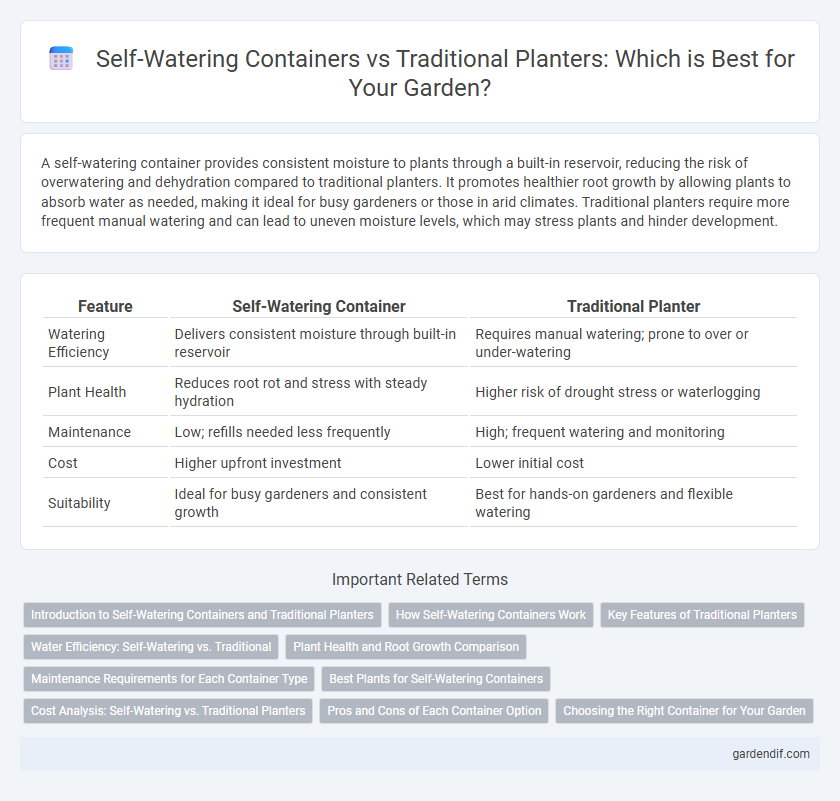
Self-watering container vs traditional planter Illustration
A self-watering container provides consistent moisture to plants through a built-in reservoir, reducing the risk of overwatering and dehydration compared to traditional planters. It promotes healthier root growth by allowing plants to absorb water as needed, making it ideal for busy gardeners or those in arid climates. Traditional planters require more frequent manual watering and can lead to uneven moisture levels, which may stress plants and hinder development.
Table of Comparison
| Feature | Self-Watering Container | Traditional Planter |
|---|---|---|
| Watering Efficiency | Delivers consistent moisture through built-in reservoir | Requires manual watering; prone to over or under-watering |
| Plant Health | Reduces root rot and stress with steady hydration | Higher risk of drought stress or waterlogging |
| Maintenance | Low; refills needed less frequently | High; frequent watering and monitoring |
| Cost | Higher upfront investment | Lower initial cost |
| Suitability | Ideal for busy gardeners and consistent growth | Best for hands-on gardeners and flexible watering |
Introduction to Self-Watering Containers and Traditional Planters
Self-watering containers feature a built-in reservoir that supplies consistent moisture to plants, reducing the frequency of watering compared to traditional planters. Traditional planters rely on manual watering and proper drainage, which can lead to inconsistent moisture levels and increased maintenance. These differences make self-watering containers ideal for busy gardeners or drought-prone areas, while traditional planters offer greater flexibility in soil type and plant variety.
How Self-Watering Containers Work
Self-watering containers utilize a water reservoir beneath the soil that supplies moisture through capillary action, ensuring consistent hydration to plant roots. This design minimizes evaporation and reduces the frequency of watering compared to traditional planters. By maintaining optimal soil moisture levels, self-watering containers promote healthier plant growth and prevent root rot caused by overwatering.
Key Features of Traditional Planters
Traditional planters rely on manual watering, which requires consistent attention to maintain soil moisture levels. They typically feature drainage holes that prevent waterlogging and promote aeration for healthy root development. These planters are often made from materials like clay, plastic, or metal, offering various aesthetic and durability options but less water efficiency compared to self-watering containers.
Water Efficiency: Self-Watering vs. Traditional
Self-watering containers optimize water use by providing a consistent moisture level through a built-in reservoir, reducing water waste and evaporation losses common in traditional planters. Traditional planters require frequent watering, often leading to uneven soil moisture and increased runoff. The improved water retention in self-watering containers supports healthier plant growth while conserving resources.
Plant Health and Root Growth Comparison
Self-watering containers promote consistent moisture levels, reducing the risk of overwatering and root rot, which enhances overall plant health. Traditional planters often require more frequent watering, leading to drought stress or waterlogging that impairs root development. Studies show that self-watering systems encourage deeper root growth and improved nutrient uptake, resulting in more resilient plants.
Maintenance Requirements for Each Container Type
Self-watering containers significantly reduce maintenance efforts by automatically regulating water levels through a reservoir, minimizing the frequency of manual watering and preventing overwatering. Traditional planters require consistent monitoring and regular watering to maintain optimal soil moisture, increasing the risk of underwatering or root rot. The self-watering system's design supports healthier plant growth with less daily attention compared to the higher maintenance demands of traditional containers.
Best Plants for Self-Watering Containers
Self-watering containers are ideal for moisture-loving plants like herbs, leafy greens, and tomatoes, which thrive with consistent hydration. Traditional planters suit drought-tolerant plants such as succulents and lavender, which prefer drying out between waterings. Choosing the right container type enhances plant growth by matching watering needs to plant species.
Cost Analysis: Self-Watering vs. Traditional Planters
Self-watering containers typically require a higher initial investment, averaging $25 to $50 compared to $10 to $20 for traditional planters, but they reduce long-term water costs by minimizing evaporation and overwatering. Traditional planters incur ongoing expenses such as frequent watering, increased soil replacement, and potential plant loss due to inconsistent moisture levels, which can elevate maintenance costs over time. Evaluating total cost of ownership, self-watering containers offer superior value through water efficiency and reduced labor, balancing higher upfront costs with long-term savings.
Pros and Cons of Each Container Option
Self-watering containers maintain consistent moisture by using a reservoir, reducing watering frequency and minimizing the risk of root rot, though they may be more expensive and less suitable for plants needing dry conditions. Traditional planters offer versatility and are typically more affordable, but require frequent watering and carry a higher risk of inconsistent moisture levels leading to plant stress. Choosing between these options depends on the gardener's maintenance preference and the specific watering needs of the plants.
Choosing the Right Container for Your Garden
Self-watering containers feature a built-in reservoir that provides consistent moisture, reducing the frequency of watering and promoting healthier root growth compared to traditional planters. Traditional planters rely on manual watering, which can lead to inconsistent moisture levels and increased risk of overwatering or underwatering. Selecting the right container depends on plant type, maintenance preferences, and local climate conditions to optimize growth and water efficiency.
Self-watering container vs traditional planter Infographic

 gardendif.com
gardendif.com